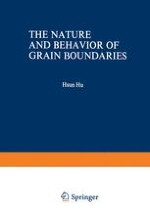1972 | Buch
Über dieses Buch
In view of the dramatically increased interest in the study of grain boundaries during the past few years, the Physical Metal lurgy Committee of The Institute of Metals Division of The Metal lurgical Society, AIME, sponsored a four-session symposium on the NATURE AND BEHAVIOR OF GRAIN BOUNDARIES, at the TMS-AIME Fall Meeting in Detroit, Michigan, October 18-19, 1971. The main ob jectives of this symposium were to examine the more recent develop ments, theoretical and experimental, in our understanding of grain boundaries, and to stimulate further studies in these and related areas. This volume contains most of the papers presented at the Symposium. It is regrettable that space limitations allow the inclusion of only four of the unsolicited papers, in addition to thirteen invited papers. The papers are grouped into three sections according to their major content: STRUCTURE OF GRAIN BOUNDARIES, ENERGETICS OF GRAIN BOUNDARIES, and GRAIN BOUNDARY MOTION AND RELATED PHENOMENA. Grain boundaries, or crystal interfaces, have been of both academic and practical interest for many years. An early seminar on "Metal Interfaces" was documented in 1952 by ASM. The Fourth Metallurgical Colloquium held in France, 1960, had a broad coverage on "Properties of Grain Boundaries". More recently the Australian Institute of Metals sponsored a conference on interfaces, with the proceedings being published by Butterworths in 1969.
Anzeige
